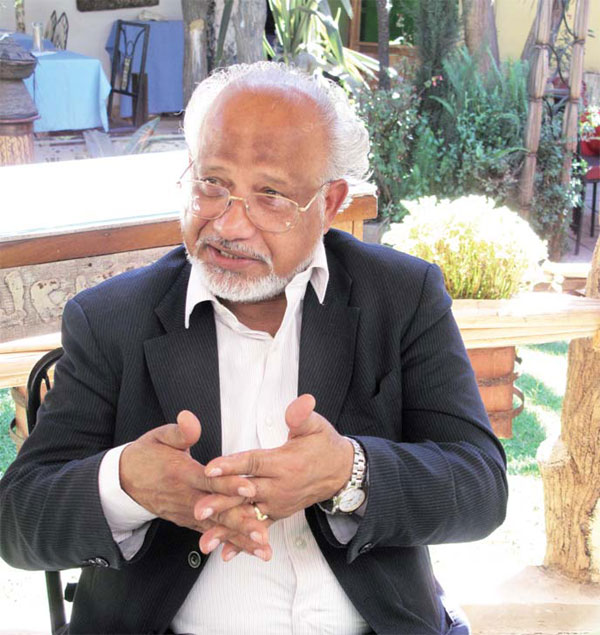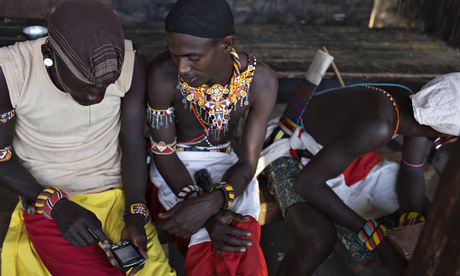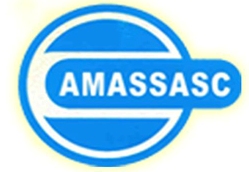European Union To Invest $38bn In Africa
.

VENTURES AFRICA – The European Union (EU) says it will invest €28 billion ($38 billion) in Africa over a period of three years, as it plans to strengthen economic development and trade relations on the continent.
This was revealed by Ambassador Roeland Van de Geer, the Head of European Union delegation, at the South African Institute of International Affairs (SAIIA) EU-Africa Summit, which held in Pretoria this week.
“We expect to make available over the next coming three years, €28 billion ($38 billion) in development assistance and we hope to push our mutual trade over the coming years considerably but we have not put any figures to that or the trade,” Van de Geer said, adding that the decision came on the heels of the EU-Africa Union Summit held in Brussels last week.
He highlighted Africa’s emerging market status and how it is continuously attracting investors, thus changing the dynamics of the relations existing between the EU and Africa.
“A central part of this summit was that Africa and Europe work together as economic partners not so much in the traditional donor, recipient role as you know economic growth in Europe has been very low over the past few years. Africa is performing relatively well. So it’s a different dynamic and different relations,” the Ambassador said.
Although the funds will be directed towards education, job creation and health, focus will be given to peace and security as well as increased development and investment in trade and economic corporation
UN-African Union report urges more credible industrial policies to transform continent
.
Workers maintain the thermal power station at Takoradi, Ghana. Photo: World Bank/Jonathan Ernst
11 April 2014 – While Africa has recorded impressive economic growth in the past decade, more credible industrial policies and institutions are needed to advance the structural transformation of the continent, says a new report released today by the United Nations and the African Union.
This year’s Economic Report on Africa, jointly produced by the UN Economic Commission for Africa (ECA) and the African Union (AU), adds that transforming Africa’s industrial landscape has failed partly because countries used industrial blueprints characterised by lack of dynamism and high level coordination, as well as inadequate consultations with stakeholders.
The report, launched at UN Headquarters in New York, builds on the work of the 2011 edition – on the role of the state in economic transformation – as well as last year’s report on leveraging Africa’s comparative advantages in commodities to industrialize.
The report tries to “dig deeper” and demonstrate that, to succeed, “industrial policy has to be organic, it has to be contextualized, it has to be specifically African,” ECA Executive Secretary Carlos Lopes said in an interview with UN Radio.
In addition, for Africa “to really make it” in terms of industrialization, it has to draw from the lessons of other emerging countries and regions.
Mr. Lopes noted that gross domestic product (GDP) on the continent has doubled in the last 10 years. At the same time, there are not enough modern jobs being created, he noted.
“We need what we are calling transformation… We are making the case that the only option for Africa to do it is through industrialization.”
Until now, according to the report, an examination of Africa’s failure at industrialization had ignored the policy processes and institutions governing industrial policy in Africa or the impact of their inherent weaknesses on industrialization.
“Indeed, weak institutional structures and poor policy design have been at the root of Africa’s industrial policy problem throughout its post-independence history,” the report declares.
While acknowledging Africa’s impressive economic growth in the past decade on the back of better commodity prices, improved governance and increasing domestic demand and trade and investment ties with emerging economies, the report says that industrialization is a “precondition for Africa to achieve inclusive and sustainable economic growth.”
Regarding the provision of modern infrastructure and logistics necessary for industrialization, the report wants governments with few resources to create “pockets of infrastructure” focused on sectoral or clustering needs of industrial expansion.
The report also recommends industrial parks as one approach which “provides high potential for growth and value addition as well as for solid linkage development and related spillovers among companies, suppliers and service providers.”
Addis Ababa light rail enters final phase
Six Countries request power purchase from Ethiopia
Ethiopian Coffee Quality Could Do Better –Traders
http://www.ventures-africa.com/2014/04/ethiopian-coffee-quality-could-do-better-traders/
.
Agency expanding health insurance coverage across nation
 The Ethiopian Health Insurance Agency said it is undertaking activities aimed at expanding health service coverage in the country.
The Ethiopian Health Insurance Agency said it is undertaking activities aimed at expanding health service coverage in the country.Agency Acting Director General, Dr Mengistu Bekele, told WIC the agency is registering members and conducting awareness raising campaign following the issuance of regulation for its establishment by the Council of Ministers.
According to Dr Mengistu, social health and community-based health insurance schemes have already begun across the country.
The social health insurance scheme will help achieve universal healthcare coverage via cost sharing between beneficiaries and the government, he indicated.
According to Dr Mengistu, financing under the social health insurance system will be covered by the contributions from employees and the government. Employees will contribute 3 percent of their monthly salary.
He said the agency has set a plan to register 11 percent of the total population under social health insurance scheme and the remaining 89 per cent under the community-based health insurance scheme.
The community-based health insurance scheme is being implemented at a pilot level in 161 woredas across the country.
Some 700,000 people have so far become beneficiaries of the community-based health insurance scheme, it was noted.http://www.waltainfo.com/index.php/explore/13012-agency-expanding-health-insurance-coverage-across-nation-
.
Canada provides over 5.6 Million USD in Grant to Support Ethiopia’s Women Entrepreneurs
.
 Canada’s Department of Foreign Affairs, Trade and Development (DFATD) has signed a 5.6 million USD grant (6.5 million Canadian dollar) with UNDP Ethiopia to build the entrepreneurial capacity of around twenty-five thousand Ethiopian women and female youth.
Canada’s Department of Foreign Affairs, Trade and Development (DFATD) has signed a 5.6 million USD grant (6.5 million Canadian dollar) with UNDP Ethiopia to build the entrepreneurial capacity of around twenty-five thousand Ethiopian women and female youth.
The support will be provided through an Entrepreneurship Development Programme (EDP), which was officially launched by Prime Minister Hailemariam Desalegn in early 2013, according the press release DFATD sent to WIC.
“The EDP seeks to support entrepreneurship development and job creation in the country by increasing the competitiveness and profitability of the Ethiopia’s micro and small enterprises (MSEs), especially those owned by women and youth”.
“Tapping into the innovative drive of entrepreneurs, particularly women and youth, is the cornerstone of UNDP’s strategy to help Ethiopia unleash the potential of the private sector to drive the country’s development agenda forward,” said Eugene Owusu, UNDP Ethiopia Resident Representative. “We are delighted to have this partnership with the Government of Canada”.
The partnership with Canada will help to strengthen the support targeted towards women’s economic empowerment through entrepreneurship training and access to customized business development service.
Female entrepreneurs in Ethiopia face a number of challenges including accessing resources such as land, education, and effective business networks. In the rural areas, women face further challenges when looking for employment in the formal sector, even though they have acquired technical skills through vocational training. Many women who do find formal jobs tend to be underemployed.
According to the 2013 National Labor-force Survey, national figures for employment at a managerial level puts women’s participation at five times less than that of their male counterparts while women make up the majority of those holding low end occupations. The story is different when it comes to the informal sector which accounts for 23.1% of all working women while only 14.7 % of working men are drawn into this sector.
“Canada is proud to help create jobs by promoting the growth of small businesses in Ethiopia, especially businesses owned by women,” said Christian Paradis, Canadian Minister of International Development and La Francophonie. “By giving businesses market access, and by encouraging investment, innovation, training, and trade, we stimulate economic growth in developing countries, and we contribute to reducing poverty.”
.
The Lowdown on Addis Ababa – Adama Expressway
.
.
Source: Roadtraffic
Addis Adaba Adama (Nazareth) expressway is an under-construction expressway in Oromia Regional State, Ethiopia. It will be first expressway in Ethiopia and East Africa when complete, and also the first toll road in the nation. The new expressway connects the capital city Addis Adaba to Adama (Nazareth).
Ethiopian Roads Authority (ERA) is the developer of the project and Chinese Communications Construction Company (CCCC) is the contractor. The project is estimated to cost $612m.
Construction of the expressway started on 21 April 2010 and is expected to finish by April 2014. The expressway will be able to accommodate 15,000 vehicles per day. The new route will help speed up the development of the country and provide job opportunities.
Addis Adaba Adama road project background and purpose
Ethiopia is one of the fastest growing nations in the world, but poor transportation facilities have become a bottleneck to the growth of agriculture in the country thereby affecting economic development. The Ethiopian Government has undertaken projects to improve the country’s transportation network. The government plans to complete 64,000km of road network by 2015.
The existing Addis Addaba Adama road carries 20,000 vehicles per day and is one of the busiest routes in the country. The road is heavily congested, which is causing frequent accidents. The new Addis Addaba Adama highway will help resolve these issues and contribute to fuel savings.
Prefeasibility studies were conducted for Adama Awash and Modjo Hawassa roads along with the Addis Abeba Adama road project. Addis Abeba Adama was given ultimate priority as the road is a segment of Addis Ababa to Djibouti Highway. Djibouti is the country’s hub for business, import and export activities.
Connection to Dijbouti port and Adama will boost the import and export sectors in the country. The new road also connects to Bale zone in Oromia Regional State, Dire Dawa, Somali region capital, Jijiga and Hawassa.
Project details of Addis Adaba Adama expressway
The Addis Adaba Adama expressway project is a part of five-year growth and transformation plan (GTP) of the Ethiopian Government. The 80km-long expressway is located in Oromia regional state.
The alignment starts from Tulu Dimtu. The main road of the expressway continues 2.8km along the proposed Addis Adaba outer ring road and then crosses Dukem, Bishoftu and Modjo on their east side. It then passes the existing Addis Adama road at 62km and bypasses around Adama on the south side. The expressway ends on the east side of Adama and connects to Adama Awash road.
The new six-lane, 12m-wide road will be constructed along a different route but will be placed adjacent to and 3.5km from the west side of the existing Addis Ababa Adama road.
The new road will be 20km shorter than the existing Addis Adaba Adama road, while the route will be fenced on either sides for protection from pedestrians and animals. Two design speeds of 100kmph and 120kmph are used for different sections of the road. The new route will have exit points for towns located between Addis Adaba and Adama.
New interchange roads will be constructed at Dukem, Akaki Bishoftu and Mojdo. The six-lane road is planned to be upgraded to eight lanes if required in the future.
Construction
The expressway has 18km of link road and 7.2km of frontage road on either side in Adama. The road work involves construction of six interchanges, three intersections, 77 slab culverts, 36 underpasses and 43 over passes. The 5.4m high overpasses are supported by 73t girders, reinforced concrete piers and stone structures. Pedestrians, agricultural vehicles and cars can use three of the underpasses.
The underpass for agricultural vehicles has a width of 4.5m and height of 3.2m. The pedestrian underpass will be 4.5m wide and 2.2m high. Car underpasses will be larger in size with 6.5m width and 4.5m height. Flood discharge will be used to size the culverts, which will be designed as per velocity, water scouring and water levels.
The project also includes construction of two main toll gates and 13 ramp toll gates.
According to ERA, approximately 50% of the construction work was finished as of September 2012. The expressway is expected to be finished six months before the scheduled date of 20 April 2014.
Traffic management and tolling on the Addis Adaba Adama expressway
The new route has introduced advanced technologies in the transportation sector of Ethiopia. The road network, with overpasses, underpasses and interchanges, needs sophisticated technologies, such as traffic management centre and intelligent transportation systems (ITS) for effective operation.
ITS facilities such as traffic cameras and variable message signs (VMS) will enable effective traffic management and incident management control along with safe operations at the new complex road.
Tolling a road is also first time for the nation and is expected to be implemented in future on the Addis Adaba Adama expressway.
Toll gates will be installed at Addis Adaba and Adama, as well as at the six interchanges that will connect the new expressway with Dukem, Bishoftu and Modjo towns. The toll road will be constructed by CCCC in three sections. Each section will have toll gates at every 17km distance. The toll road will reduce the travel time to around 40 minutes from the average two hours between Addis Adaba and Adama.
Addis Adaba Adama expressway funding
The project is financed through $350m soft loan from Export-Import (Exim) Bank, with the remaining $262m coming from the Ethiopian Government.
http://nazret.com/blog/index.php/2014/04/10/ethiopia-the-lowdown-on-addis
.
Electronic Single Window Report Due Next Week
.
The single window system will target the easing of regulatory obligations for import, export and transit clearance
Consultants hired by the World Bank will finalise a business process re-engineering (BPR) report for the design and implementation of an Electronic Single Window (ESW) by the end of next week. This window will be used by a number of government entities, including the Ethiopian Revenues & Customs Authority (ERCA).
The consultants, were hired in January by the International Financial Corporation (IFC) – the financial arm of the WB – to work closely with government agencies and ministries in optimising and modernising business processes related to the issuances of permits and licenses.
The reengineering process is preceding the installation of the ESW system, which is aimed at providing a single electronic point of access for traders to lodge all trade related information and discharge all regulatory obligations for import, export and transit clearance.
Other government bodies where the system will be implemented include the Food, Medicine & Health Care Administration & Control Authority (FMHACA), the Ministry of Agriculture (MoA), Ministry of Communication & Information Technology (MoCIT), the Ethiopian Shipping Lines & Logistics Service Enterprise (ESLSE) and the National Bank of Ethiopia (NBE). Processes in these institutions are all currently predominantly paper-based, according to the study presented by the consultants on Wednesday, April 2, 2014, during a workshop on the ESW at the Sheraton Addis Hotel.
Paper processes have remained unchanged for several years and represent a hindrance to trade, the consultants said. The fees for services, though relatively modest, involve high transaction cost and are often cash-based. Other hindrances, according to the consultants, included the unavailability of a national trade transaction overview and the non-existence of cross-agency procedures, as well as duplicate roles among several agencies.
The consultants have developed new business processes and procedures to leverage automation through the ESW based on a harmonised data set and common procedures, reflecting risk based approaches to compliance.
The new procedures will result in the significant reduction of paper-based procedures and enable all traders to access documents from their premises, thus eliminating visits to ministries, said Christer Andersson, one of the consultants.
Consultants discussed their findings and recommendations with the ministries and agencies on April 3 and 4, 2014. Preparation of a final draft of the BPR report, including process mapping, proposed revised objectives and proposed reengineered processes, is expected to be finalised by the end of next week.
Electronic import-export processes have to apply global standards that are locally adapted.
“Local realities are vital,” Andersson said. “Global standards can only be maintained so long as they are married to local realities.”
The proper implementation of the system enables local exporters to be competent in international markets and also makes imported goods affordable to local consumers, Andersson said.
The Investment Climate Fund has provided 4.3 million out of the total project cost of 7.3 million dollars; the World Bank’s IFC has provided another 600,000 dollars, with the balance coming from the government of Ethiopia.
The ERCA floated an international tender on March 30, 2014, for the supply and implementation of the ESW. The tender, which will close on April 16, 2014, has invited international vendors for the system that includes facilitation of e-payments, digital certificates and the monitoring of transactions, according to Nigussie Seid, project manager of the ESW at the Authority.
This is not the first time for the Authority to invite qualified vendors for the installation of the ESW system. The first time was a year ago, but it was cancelled because the process took longer than three months – the minimum period according to the public procurement and tender requirements – says Melesew Hailemariam, communications officer at the Authority.
“This time tender process will be finalised within the three-month deadline,” Melesew told Fortune.
Authorities at the ERCA declined to disclose the price offered by the previous international vendor that qualified in the earlier tender.
http://addisfortune.net/articles/electronic-single-window-report-due-next-week/
.
High-level dinner debate on African agriculture
.
Oslo, April 10, 2014
Building partnerships
The role of partnerships and the private sector were pivotal points in the conversations. The high-level dinner panel took place during the 4th Africa-EU Summit, and hosted senior representatives from EU institutions, national governments, farmers and farmers’ organizations, the private sector, associations, donors and development partners.
They discussed the opportunities for investment in African agriculture and the importance of building partnerships to increase productivity and improve the livelihoods of smallholder farmers.
The dinner was hosted by the respected think-tank Friends of Europe. Speakers included Erastus Mwencha, Deputy Chairperson of the African Union Commission; Andris Piebalgs, EU Commissioner for Development; Ibrahim Assane Mayaki, CEO of New Partnership for Africa’s Development (NEPAD); Geoffrey Kirenga, CEO of Southern Agricultural Growth Corridor of Tanzania (SAGCOT); and Tumusiime Rhoda Peace, AU Commissioner for Rural Economy and Agriculture.
“We need to make agriculture a business, because at the moment in Africa agriculture is simply for subsistence,” said Erastus Mwencha.
Yara supported the dinner and was represented by CEO Jørgen Haslestad. “Without having the international and local private companies involved, we will not be able to have the success which is needed,” he said.
The African Union has declared 2014 the year of agriculture and food security. The speakers and the audience addressed several questions, including multi-sectorial interventions, the role of the private sector and how African agriculture can benefit from initiatives such as ‘Grow Africa’.
Video here: High-level dinner debate on African agriculture.
.
The video features conversation from the CEO, Erastus Mwencha, Lucy Muchoki (CEO of the Kenyan Agribusiness and Agri-industry Alliance) and Steven Muchiri (Executive Director of the Eastern Africa Farmers Federation)
http://www.yara.com/media/news_archive/dinner_debate_on_african_agriculture.aspx
.
Filed under: Ag Related Tagged: Addis Ababa, Agriculture, Business, Economic growth, Ethiopia, Investment, Millennium Development Goals, Sub-Saharan Africa, tag1



 Six Countries have Requested to Buy Power from Ethiopia Besides selling Electric power to Sudan and Djibouti, FBC writes that Kenya, Yemen, Tanzania, Uganda, Burundi and Rwanda have requested to buy power from Ethiopia.
Six Countries have Requested to Buy Power from Ethiopia Besides selling Electric power to Sudan and Djibouti, FBC writes that Kenya, Yemen, Tanzania, Uganda, Burundi and Rwanda have requested to buy power from Ethiopia.








 Soil fertility map is part of the plans to enhance agricultural productivity set out by MoA. It prioritizes replenish soil fertility and more cautious use of fertilizers.
Soil fertility map is part of the plans to enhance agricultural productivity set out by MoA. It prioritizes replenish soil fertility and more cautious use of fertilizers.
 As dusk falls on Addis Ababa, it is easy to spot the shadows of the giant cranes that are busy laying the rails for Ethiopia’s ambitious light-rail transit system.
As dusk falls on Addis Ababa, it is easy to spot the shadows of the giant cranes that are busy laying the rails for Ethiopia’s ambitious light-rail transit system.









 The AP is
The AP is  A grant aid signing ceremony was held today between the governments of Japan and Ethiopia.
A grant aid signing ceremony was held today between the governments of Japan and Ethiopia. Some 12 new road projects are under implementation at a cost of over 14.3 billion birr, according to the Ethiopian Road Authority (ERA).
Some 12 new road projects are under implementation at a cost of over 14.3 billion birr, according to the Ethiopian Road Authority (ERA). Ethiopian Railways Corporation (ERC) is planning to hire an international company which would be responsible to manage operations once the Addis Light Rail Transit (AA-LRT) commences service.
Ethiopian Railways Corporation (ERC) is planning to hire an international company which would be responsible to manage operations once the Addis Light Rail Transit (AA-LRT) commences service. Asian Paints (International) Ltd (APIL), a wholly owned subsidiary of India’s largest paints company Asian Paints Ltd, has agreed to buy 51 per cent equity stake in Ethiopia-based Kadisco Chemical Industry Plc for an undisclosed amount, according to a stock market disclosure.
Asian Paints (International) Ltd (APIL), a wholly owned subsidiary of India’s largest paints company Asian Paints Ltd, has agreed to buy 51 per cent equity stake in Ethiopia-based Kadisco Chemical Industry Plc for an undisclosed amount, according to a stock market disclosure.


.JPG)











 The Ministry of Federal Affairs (MoFA) said the 3rd phase Pastoralist Community Development Project (PCDP-3) will be commenced next month.
The Ministry of Federal Affairs (MoFA) said the 3rd phase Pastoralist Community Development Project (PCDP-3) will be commenced next month. The Ethiopian Road Authority (ERA) said it has built, repaired and upgraded over 12, 620 km of road with 19.1 billion birr during the last nine months of this budget year.
The Ethiopian Road Authority (ERA) said it has built, repaired and upgraded over 12, 620 km of road with 19.1 billion birr during the last nine months of this budget year. Two of the nine companies floated by the Privatization and Public Enterprises Supervising Agency (PPESA) attracted bids, the agency said.
Two of the nine companies floated by the Privatization and Public Enterprises Supervising Agency (PPESA) attracted bids, the agency said.
 Enat Bank announced special interest rates for women at press conference it called at its headquarters on Wednesday April 16, 2014, Fortune reported.
Enat Bank announced special interest rates for women at press conference it called at its headquarters on Wednesday April 16, 2014, Fortune reported.
 Representatives from Sakai Heavy Industries PLC visited Ethiopia to introduce the company’s newly designed road stabilizer machine, The Reporter reported.
Representatives from Sakai Heavy Industries PLC visited Ethiopia to introduce the company’s newly designed road stabilizer machine, The Reporter reported.















 Ethiopia will have a Hydrogen Peroxide Chemical factory by July 2014, Ethiopian News Agency reported. The factory is being built by Awash Melkasa Aluminum Sulfate and Sulfuric Acid Share Company at a cost of 200 Million Birr.
Ethiopia will have a Hydrogen Peroxide Chemical factory by July 2014, Ethiopian News Agency reported. The factory is being built by Awash Melkasa Aluminum Sulfate and Sulfuric Acid Share Company at a cost of 200 Million Birr. Ethiopian Agricultural Research Institute (EARI) has developed a new variety of rice that can yield 104 quintals per hectare, The Ethiopian Herald reported.
Ethiopian Agricultural Research Institute (EARI) has developed a new variety of rice that can yield 104 quintals per hectare, The Ethiopian Herald reported.

























